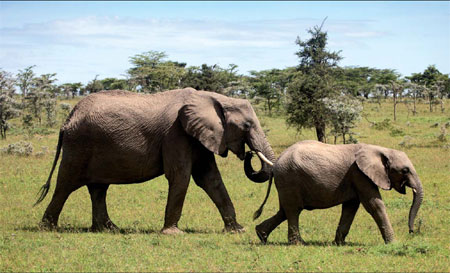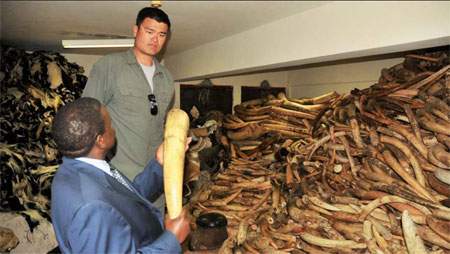Back to nature
Updated: 2013-03-15 11:10
By Li Lianxing (China Daily)
|
||||||||
|
Above: Elephants roam in the Masai Mara reserve in Kenya. Below: Director of Kenya Wildlife Services Julius Kipn'getich shows former Chinese basketball star Yao Ming seized elephant tusks held at the KWS strong room. Yao visited Kenya in 2012 to film a documentary on the poaching of elephants and rhinos. Xie Songxin / China Daily |
An estimated elephant population of 1.3 million in 1979 had been cut to about 450,000 by 2007, according to testimony provided to the United States Congress by Iain Douglas-Hamilton, a founder member of Save the Elephants, who has been conducting research into African elephants for more than 45 years.
And the trade doesn't just involve elephant ivory carvings and artworks. Some people still believe that powdered rhino horn is a medicine or aphrodisiac. In fact, the horn is mainly composed of bone covered by a layer of keratin, a substance also found in human hair and nails. In 1993, the Chinese government banned the use of rhino horn as a medicine.
In the first nine months of 2012, 388 rhinos were killed by poachers in Kruger National Park and provinces such as Limpopo, KwaZulu-Natal and North West, according to South African government statistics.
The country is home to about 22,000 white and 4,800 black rhino, which represent 93 percent of the world's total population.
"The illegal wildlife trade in the 21st century has an estimated value of $7.8 billion to $10 billion per annum, a figure which, if correct, would make it the fifth-largest illicit transnational activity globally, after counterfeiting and the illegal trades in drugs, people and oil," says Douglas-Hamilton.
The eradication of poaching in Africa depends on rooting out the market for the products, which experts agree is mainly in Asia.
|
||||
"We would definitely be infuriated if someone killed our pandas, so we are also very sad about the rhino and elephant poaching here in Africa.
"I believe that once Chinese consumers learn of the serious consequences of buying these products, they will change their minds."
In October, Li Yuchun, one of China's pop singers, also visited a number of Kenyan nature conservancies to raise awareness about elephant and rhino protection.
As a result of such celebrity appeals and education programs, more Chinese are becoming concerned by the deteriorating security situation for African wildlife and are interested in contributing to protection campaigns.
Increased efforts
As a measure of China's international cooperation on environmental and wildlife conservation, senior officials from Shanghai Municipality last month signed agreements with the United Nations Environment Programme in Nairobi on the green economy, wildlife protection and supporting youth engagement.
"Shanghai agreed to use its large-screen displays in the city center and posters in stations of the extensive Shanghai Metro rail network to demonstrate UNEP's prioritized themes, including the campaign for wildlife protection launched this year in collaboration with the Convention on International Trade in Endangered Species," says a UNEP press release.
Like China's wildlife protection, which has been receiving international support, Africa's conservation also needs help from outside, says Xie Yan, director of the China program of the Wildlife Conservation Society.
"For instance, pandas are a species that has received relatively a lot of research work and better protection. The real start-up research originated in the 1980s with an expert from the WCS," he says of the first collaboration on wildlife protection between China and foreign groups.

 Li Na on Time cover, makes influential 100 list
Li Na on Time cover, makes influential 100 list
 FBI releases photos of 2 Boston bombings suspects
FBI releases photos of 2 Boston bombings suspects
 World's wackiest hairstyles
World's wackiest hairstyles
 Sandstorms strike Northwest China
Sandstorms strike Northwest China
 Never-seen photos of Madonna on display
Never-seen photos of Madonna on display
 H7N9 outbreak linked to waterfowl migration
H7N9 outbreak linked to waterfowl migration
 Dozens feared dead in Texas plant blast
Dozens feared dead in Texas plant blast
 Venezuelan court rules out manual votes counting
Venezuelan court rules out manual votes counting
Most Viewed
Editor's Picks

|

|

|

|

|

|
Today's Top News
Boston bombing suspect reported cornered on boat
7.0-magnitude quake hits Sichuan
Cross-talk artist helps to spread the word
'Green' awareness levels drop in Beijing
Palace Museum spruces up
First couple on Time's list of most influential
H7N9 flu transmission studied
Trading channels 'need to broaden'
US Weekly

|

|














